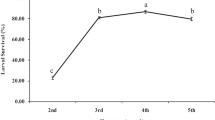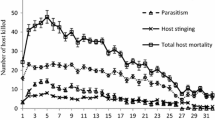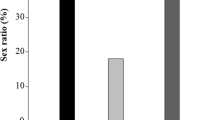Abstract
The current study was designed to assess the effect of different feeding substrates on survival and reproduction of Therophilus javanus (Bhat & Gupta) (Hymenoptera: Braconidae) and Phanerotoma syleptae Zettel (Hymenoptera: Braconidae) in order to optimize their potential as biological control agents against Maruca vitrata Fabricius (Lepidoptera: Crambidae). Experiments were carried out in laboratory with batches of ten adult females exposed to flowers of either Vigna unguiculata (L) Walp., Tephrosia candida (Roxb.) DC, and Sesbania rostrata Bremek & Oberm, pure honey, honey solution, or saccharide solution to assess parasitoid survival. Parasitoid fecundity was evaluated with separate couples of each species using the same substrates. The highest longevity and mean fecundity were obtained for the parasitoids exposed to Tephrosia candida flowers, while there was no difference between control (starved adults) and adults fed using S. rostrata flowers. The putative nutritional compounds of different flowers used in our study affected the biological parameters and performance of these parasitoids differently. Flowers of Tephrosia candida can serve as feeding substrates to both P. syleptae and T. javanus. This study suggests the possibility of using host plants at the flowering stage as a release point for the deployment of the two parasitoids in a classical biological control programme against M. vitrata.




Similar content being viewed by others
References
Aboubakar Souna D, Bokonon-Ganta AH, Dannon EA, Imorou N, Agui B, Cusumano A, Srinivasan R, Pittendrigh BR, Volkoff AN, Tamò M (2020) Volatiles from Maruca vitrata (Lepidoptera, Crambidae) host plants influence olfactory responses of the parasitoid Therophilus javanus (Hymenoptera, Braconidae, Agathidinae) Biological Control 130: 104–109
Arnó J, Oveja MF, Gabarra R (2018) Selection of flowering plants to enhance the biological control of Tuta absoluta using parasitoids. Biol Control 122:41–50
Arodokoun D, Tamò M, Cloutier C, Adeoti R (2003) Importance of alternative host plants for the annual cycle of the legume pod borer, Maruca vitrata Fabricius (Lepidoptera: Pyralidae) in Southern and Central Benin. Insect Sci & Appl. 23:103–113
Arthur AP, Wylie HG (1959) Effects of host size on sex ratio, development time and size of Pimpla turionellae (L.) (Hymenoptera: Ichneumonidae). Entomophaga 4:297–301
Baggen LR, Gurr GM (1998) Flowers in tri-trophic systems: mechanisms allowing selective exploitation by insect natural enemies for conservation biological control. Entomol Exp Appl 91:155–161
Barbosa P, Saunders JA, Kemper J, Trumbule R, Olechno J, Martinat P (1986) Plant allelochemicals and insect parasitoids: Effect of nicotine on Cotesia congregata (Say) (Hymenoptera: Braconidae) and Hyposoter annulipes (Cresson) (Hymenoptera: Ichneumonidae). J Chem Ecol 12:1319–1328
Barrett M, Schmidt JM (1991) A comparison between the amino acid composition of an egg parasitoid and some of its hosts. Entomol Exp Appl 59:29–41
Benelli G, Giunti G, Tena A, Desneux N, Caselli A, Canale A (2017) The impact of adult diet on parasitoid reproductive performance. J Pest Sci 90(3):807–823
Berndt LA, Wratten SD (2005) Effects of alyssum flowers on the longevity, fecundity, and sex ratio of the leafroller parasitoid Dolichogenidea tasmanica. Biol Control 32:65–69. https://doi.org/10.1016/j.biocontrol.2004.07.014
Brodeur J, Boivin G (2004) Functional ecology of immature parasitoids. Annu Rev Entomol 49:27–49
Chau NNB, Kieu NTP, Dung NVT, Quoc NB, Phuong TK (2019) Effects of floral resources on the longevity and parasitism of Cotesia vestalis Haliday (Hymenoptera: Braconidae) on Plutella xylostella (L.) (Lepidoptera: Plutellidae) in Vietnam. Heliyon 5:e02258
Colinet H, Salin C, Boivin G, Hance Th (2005) Host age and fitness-related traits in a koinobiont aphid parasitoid. Ecol Entomol 30:473–479
Dannon EA, Tamò M, van Huis A, Dicke M (2010) Functional response and life history parameters of Apanteles taragamae, a larval parasitoid of Maruca vitrata. Biocontrol 55:363–378
Dicke M (1999) Direct and indirect effects of plants on the performance of beneficial organisms. In: Ruberson JR (ed) Handbook of Pest Management. Marcel Dekker Inc, New York, USA, pp 105–153
Fuchsberg JR, Yong TH, Losey JE, Carter ME, Hoffmann MP (2007) Evaluation of corn leaf aphid Rhopalosiphum maidis (Homoptera: Aphididae) honeydew as a food source for the egg parasitoid Trichogramma ostriniae (Hymenoptera: Trichogrammatidae). Biol Control 40:230–236. https://doi.org/10.1016/j.biocontrol.2006.10.009
Harvey JA, Bezember TM, Elzinga JA, Strand MR (2004) Development of the solitary endoparasitoid Microplitis demolitor: Host quality does not increase with host age and size. Ecol Entomol 29:35–43
Hermosin I, Chión RM, Cabezudo MD (2003) Free amino acid composition and botanical origin of honey. Food Chem 88:263–268
Hodek I (1962) Essential and alternative food in insects. - Verh. XI Intern. Kongr. Entom., W; en (1960), Z, 698–699
Hopkinson JE, Zalucki MP, Murray DAH (2013) Honeydew as a source of nutrition for Lysiphlebus testaceipes (Cresson) (Hymenoptera: Braconidae): effect of adult diet on lifespan and egg load. Aust J Entomol 52:14–19. https://doi.org/10.1111/j.1440-10076055.2012.00875.x
Hu H-Y, Chen Z-Z, Duan B-S, Zheng J-T, Zhang T-X (2012) Effects of female diet and age on offspring sex ratio of the solitary parasitoid Pachycrepoideus vindemmiae (Rondani) (Hymenoptera, Pteromalidae). Rev Bras Entomol 56:259–262. https://doi.org/10.1590/S0085-56262012005000028
Jervis MA, Kidd NA (1986) Host feeding strategies in hymenopteran parasitoids. Biological Review 61:395–434
Jervis MA, Ellers J, Harvey JA (2008) Resource acquisition, allocation and utilization in parasitoid reproductive strategies. Annu Rev Entomol 53:361–385
Jervis MA, Kidd NAC (1996) Insect natural enemies, practical approaches in their study and evaluation. M. Jervis and N. Kidd. London, Chapman & Hall. 394 p
King BH (1987) Offspring sex ratios in parasitoid wasps. Q Rev Biol 62:367–396
Leatemia JA, Laing JE, Corrigan JE (1995) Effets de la nutrition des adultes sur la
Lee JC, Heimpel GE, Leibee GLS (2007) En comparant les régimes de nectar floral et de miellat des pucerons sur la longévité et les niveaux de nutriments d’une guêpe parasitoïde. Entomol Exp Appl 111:189–199
Mitsunaga T, Shimoda T, Yano E (2004) Influence of diet on the longevity and parasitic capacity of the endoparasitoid, Cotesia plutellae (Hymenoptera: Braconidae). Appl Entomol Zool 39(4):691–697
Onagbola EO, Fadamiro HY, Mbata GN (2007) Longevity, fecundity, and progeny sex ratio of Pteromalus cerealellae in relation to diet, host provision and mating. Biol Control 40:222–229
Röse USR, Lewis J, Tumlinson JH (2006) Extrafloral nectar from cotton (Gossypium hirsutum) as a food source for parasitic wasps. Funct Ecol 20(1):67–74
SAS Institute Inc (2011) Base SAS® 9.2 Procedures Guide. Cary NC, SAS Institute Inc
Shaw SP (1997) Rearing of parasitic Hymenoptera. AES 25:1–46
Sivinski J, Wahl D, Holler T, Al Dobai S, Sivinski R (2011) Conserving natural enemies with flowering plants: estimating floral attractiveness to parasitic Hymenoptera and attraction’s relationship to flower and plant morphology. Biol Control 58:208–214
Srinivasan R, Yule S, Chang JC, Malini P, Lin MY, Hsu YC, Schafleitner R (2012) Towards developing a sustainable management strategy for legume pod borer, Maruca vitrata on yard–long bean in Southeast Asia. In: R Holmer, G Linwattana, P Nath et JDH Keatinge (eds), SEAVEG 2012: Proceedings of the Regional Symposium on High Value Vegetables in Southeast Asia: Production, Supply and Demand, pp 76–82
Stapel JO, Cortesero AM, De Moraes CM, Tumlinson JH (1997) Extrafloral nectar, honeydew and sucrose effects on searching behavior and efficiency of Microplitis croceipes (Hymenoptera: Braconidae) in cotton. Environ Entomol 26:617–623
Tamò M, Ekesi S, Maniania NK, Cherry A (2003) Biological control, a non-obvious component of IPM for cowpea. In: Neuenschwander P, Borgemeister C, Langewald J (eds) Biological control in IPM systems in Africa. CAB International, Wallingford, Oxon, pp 295–309
Temerak SA (1983) Adult longevity of Brevicornis ptarmigan (Hym: Braconidae) influenced by the feeding of artificial and natural foods. Entomophaga 28:145–150. https://doi.org/10.1007/BF02372138
Ueno T (1999) Host-size-dependent sex ratio in a parasitoid wasp. Researches on Population Ecology 41:47–57
Van Alphen JJM, Visser ME (1990) Superparasitism as an adaptive strategy for insect parasitoids. Annu Rev Entomol 35:59–70
Vattala HD, Wratten SD, Phillips CB, Wäckers FL (2006) The influence of flower morphology and nectar quality on the longevity of a parasitoid biological control agent. Biological Cont 39:179–185
Wäckers FL (2001) Une comparaison des sucres de nectar et de miellat en ce qui concerne leur utilisation par le parasitoïde de l’hyménoptère Cotesia glomerata. J Insect Physiol 47:1077–1084
Wäckers FL, Lee JC, Heimp GE, Winkler K, Wagenaar R (2005) Hymenopteran parasitoids synthesize oligosaccharides specific to honeydew. Function School 20:790–798
Wang XY, Yang ZQ, Wu H, Gould JR (2008) Effects of host size on the sex ratio, clutch size, and size of adult Spathius agrili, and ectoparasitoid of emerald ash borer. Biological Cont 44:7–12
Winkler K, Wäckers F, Bukovinszkine-Kiss G, van Lenteren J (2006) Sugar resources are vital for Diadegma semiclausum fecundity under field conditions. Basic Appl Ecol 7:133–140
Zera AJ, Clark R, Behmer ST (2016) Lipogenesis in a wing-polymorphic cricket: Canalization versus morph-specific plasticity as a function of nutritional heterogeneity. J INsect Physiol 95(2016):118–132
Zhu PY, Gurr GM, Lu ZX, Heong KL, Chen GH (2012) Laboratory screening supports the selection of sesame (Sesamum indicum) to enhance Anagrus spp. parasitoids (Hymenoptera: Mymaridae) of rice planthoppers. Biol Control 64:83–89
Acknowledgements
This work was carried out with the support of the CGIAR Research Program on Grain Legumes and Dryland Cereals (GLDC) through the International Institute of Tropical Agriculture (IITA), the Deutsche Gesellschaft für Internationale Zusammenarbeit (GIZ), United States Agency for International Development (USAID) and Bill & Melinda Gates Foundation (BMGF) . We also grateful to Mathias Azokpota, François Onikpo, Basile Dato of IITA-Benin for their technical assistance during this study.
Author information
Authors and Affiliations
Corresponding author
Ethics declarations
Ethical standards
The study did not include humans as subject; therefore, ethical standards were not applicable.
Conflict of interest
The authors declare that they have no conflict of interest.
Additional information
Publisher's Note
Springer Nature remains neutral with regard to jurisdictional claims in published maps and institutional affiliations.
Rights and permissions
About this article
Cite this article
Dannon, E.A., Azokpota, E.T., Zanzana, K. et al. Effect of adult feeding substrates on survival and reproduction of Therophilus javanus and Phanerotoma syleptae, two parasitoids of Maruca vitrata. Int J Trop Insect Sci 42, 3073–3082 (2022). https://doi.org/10.1007/s42690-022-00844-0
Received:
Accepted:
Published:
Issue Date:
DOI: https://doi.org/10.1007/s42690-022-00844-0




